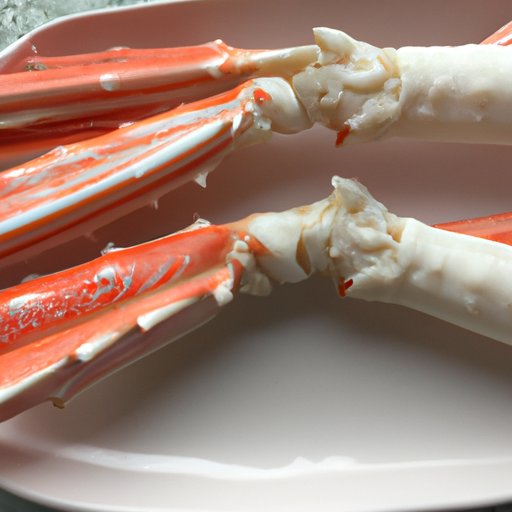Introduction
Crab legs are a popular seafood dish enjoyed around the world. They are rich in many essential vitamins and minerals, making them a great addition to any balanced diet. In this article, we will explore the nutritional benefits of crab legs and discuss how they can be incorporated into a healthy lifestyle.

Exploring the Nutritional Benefits of Crab Legs
Crab legs are a great source of lean protein, providing up to 20 grams per 3 ounce serving. They are also low in fat and cholesterol, making them an ideal choice for those looking to reduce their intake of saturated fat and calories. Crab legs are also rich in omega-3 fatty acids, which have been linked to improved heart health and cognitive function.

A Closer Look at the Macronutrients in Crab Legs
In addition to the high protein content, crab legs are also a good source of various micronutrients. They contain significant amounts of zinc, selenium, phosphorus, magnesium, and calcium. These minerals are important for maintaining strong bones and teeth, as well as protecting against chronic diseases. Crab legs are also a great source of B vitamins, which are essential for energy production and metabolism.

Examining the Role of Crab Legs in Weight Management
The high protein content in crab legs makes them a great option for those looking to lose or maintain weight. Protein is known to promote satiety, which helps to reduce hunger cravings and overeating. Additionally, the low-fat and low-calorie content of crab legs means that you can enjoy them without worrying about consuming too many calories.
Comparing the Nutritional Value of Different Types of Crab Legs
When it comes to the nutritional value of different types of crab legs, there are some minor differences. For instance, king crab legs tend to be higher in calories than snow or dungeness crab legs. However, all types of crab legs are generally considered to be nutritious and provide similar levels of protein and micronutrients.
How to Incorporate Crab Legs into a Healthy Diet
There are many ways to incorporate crab legs into a healthy diet. Steamed or boiled crab legs make a tasty and nutritious side dish. They can also be used to top salads or incorporated into main dishes such as pasta or stir-fries. When preparing crab legs, it’s important to avoid adding too much salt or butter, as this can significantly increase the calorie and fat content.
Discussing Ways to Incorporate Crab Legs into a Balanced Diet
To make sure you’re getting the most out of your crab legs, it’s important to pair them with other healthy foods. Try to include plenty of fruits and vegetables with each meal, as well as other sources of lean protein such as fish, chicken, or tofu. Whole grains and legumes are also great additions to any balanced plate.
Identifying Potential Health Risks Associated with Eating Crab Legs
Although crab legs are generally considered safe to eat, there are some potential health risks associated with consuming them. It’s important to be aware of the presence of mercury in certain types of seafood, including crab legs. Additionally, crab legs may contain harmful bacteria or parasites, so it’s important to cook them thoroughly before eating.
Conclusion
Overall, crab legs are an excellent source of protein and other essential nutrients. They are low in fat and calories, making them a great choice for those looking to lose or maintain weight. Crab legs are also a good source of omega-3 fatty acids, which have been linked to improved heart health and cognitive function. When incorporating crab legs into a healthy diet, it’s important to pair them with other nutritious foods and avoid adding too much salt or butter. Lastly, it’s important to be aware of the potential presence of mercury and harmful bacteria in certain types of seafood.

Summary of the Nutritional and Health Benefits of Crab Legs
Crab legs are a great source of lean protein, providing up to 20 grams per 3 ounce serving. They are also low in fat and cholesterol, making them an ideal choice for those looking to reduce their intake of saturated fat and calories. Crab legs are also rich in omega-3 fatty acids, which have been linked to improved heart health and cognitive function. Additionally, they are a good source of various micronutrients, including zinc, selenium, phosphorus, magnesium, and calcium.
Recommendations for Incorporating Crab Legs into a Healthy Diet
When incorporating crab legs into a healthy diet, it’s important to pair them with other nutritious foods and avoid adding too much salt or butter. Steamed or boiled crab legs make a tasty and nutritious side dish, while they can also be used to top salads or incorporated into main dishes such as pasta or stir-fries. Lastly, it’s important to be aware of the potential presence of mercury and harmful bacteria in certain types of seafood.
(Note: Is this article not meeting your expectations? Do you have knowledge or insights to share? Unlock new opportunities and expand your reach by joining our authors team. Click Registration to join us and share your expertise with our readers.)
